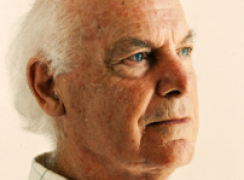The visionary state is achieved via meditation, drugs, lucid dreams, daydreams, or art. One example is Hildegard of Bingen, a 12th-century artist/visionary and Catholic saint.[1] Other visionaries in religion are St Bernadette and Joseph Smith (said to have had a vision of and communed with the Blessed Virgin, and the Angel Moroni respectively).
Contents |
Extended meanings [edit]
A vision can be political, religious, environmental, social, or technological in nature. By extension, a visionary can also be a person with a clear, distinctive, and specific (in some details) vision of the future, usually connected with advances in technology or social/political arrangements. For example, Ted Nelson is referred to as a visionary in connection with the Internet.[2]Other visionaries simply imagine what does not yet exist but might some day, as some forms of visioning (or gazing) provide a glimpse into the possible future. Therefore, visioning can mean seeing in a utopian way what does not yet exist on earth—but might exist in another realm—such as the ideal or perfect realm as imagined or thought. Examples are Buckminster Fuller in architecture and design, Malcolm Bricklin in the automobile industry and Ada Lovelace in computing. Some people use mathematics to make visionary discoveries in the nature of the universe. In that sense, a visionary may also function as a secular prophet. Some visionaries emphasize communication, and some assume a figurehead role in organizing a social group.
In art [edit]
Main article: visionary art
Artists may produce work loosely categorized as visionary art for its luminous content and/or for its use of artistic techniques that call for the use of extended powers of perception in the viewer: (e.g. Gustave Moreau, Samuel Palmer, Jean Delville, Ernst Fuchs, the French Symbolist Odilon Redon, Brion Gysin, Max Ernst, Stanley Spencer, Edward Burne-Jones, Adolf Wolfli, Fred Sandback, William Blake, Hieronymus Bosch, and Henry Darger).Visionary art can be incorrectly defined as a category of primitive art (art of those not formally trained) rather than describing people who have used their visions (or dreams) to create their paintings. Salvador Dalí is one artist who would exemplify visionary art that is neither religious nor primitive.
Notes [edit]
References [edit]
- Celestial Visitations The Art of Gilbert Williams (Pomegranate Artbooks) ISBN 0-517-53900-4, 1979
- Carlo McCormick Sacred Mirrors: The Visionary Art of Alex Grey", Inner Traditions International, 1990
- Joseph Nechvatal William Blakeand Visionary Art
- Metamorphosis: 50 Contemporary Surreal, Fantastic and Visionary Artists (beinArt) ISBN 978-0-9803231-0-8
- John Maizels,Raw Creation: Outsider Art and Beyond (1996). ISBN 0-7148-3149-2
- Elka Spoerri, Daniel Baumann and E. M. Gomez, The Art of Adolf Wolfli (2003). ISBN 0-691-11498-6
- Geiger, John (2005). Nothing Is True - Everything Is Permitted: The Life of Brion Gysin. The Disinformation Company, 130. ISBN 19328571251.
- R. Todd Wise The Great Vision of Black Elk as Literary Ritual", in The Black Elk Reader, 2000. ISBN 0-8156-2836-6
- Fantastic Art (Taschen) ( Schurian, Prof. Dr. Walter) ISBN 978-3-8228-2954-7 (English edition), 2005
- Metamorphosis (beinArt) ISBN 978-0-9803231-0-8, 2007
- Cosmic Art Ramond & Lila Piper (Hawthorne Books) ISBN 0-8015-1774-5, 1975
Category:Fantastic art
From Wikipedia, the free encyclopedia

No comments:
Post a Comment